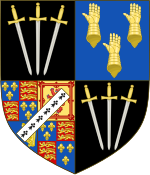This article needs additional citations for verification. (June 2015) |
Duke of Cleveland was a title that was created twice, once in the Peerage of England and once in the Peerage of the United Kingdom. The dukedoms were named after Cleveland in northern England.
| Dukedom of Cleveland | |
|---|---|
  Arms: Quarterly: 1st and 4th Grand-Quarters, Sable, three Swords in pile points downwards proper (Powlett); 2nd Grand-Quarters, Azure, three sinister Gaunlets Or (Vane); 3rd Grand-Quarters, grand-quarterly, 1st & 4th, Azure, three Fleurs-de-lis Or (France); 2nd & 3rd, Gules, three Lions Or, armed and langued Azure (England); 2nd grand-quarter, Or, a Lion rampant Gules, within a Double-Tressure flory counter-flory Gules (Scotland); 3rd grand-quarter, Azure, a Harp Or, stringed Argent (Ireland); charged at the centre point with a Baton Sinister Ermine (FitzRoy). Crests: 1st: a Dexter Gauntlet proper, bossed and rimmed Or, brandishing a Sword proper (Vane); 2nd: On a Chapeau Gules, turned up Ermine, a Lion passant guardant Or, gorged with a Collar compony Ermine and Azure, and crowned with a Ducal Coronet Gold (FitzRoy). Supporters: Dexter: A Lion Guardant Or, ducally crowned Azure, and gorged with a Collar compony Ermine and Azure. The 4th Duke’s arms are surrounded by the circlet of the Order of the Garter | |
| Creation date | 29 January 1833 |
| Creation | Second |
| Created by | King William IV |
| Peerage | Peerage of the United Kingdom |
| First holder | William Vane, 1st Marquess of Cleveland |
| Last holder | Harry Powlett, 4th Duke of Cleveland |
| Remainder to | 1st Duke's heirs male of the body lawfully begotten |
| Subsidiary titles | Marquess of Cleveland Earl of Darlington Earl of Chichester Viscount Barnard Baron Barnard Baron Raby Baron Newbury |
| Status | Extinct |
| Extinction date | 21 August 1891 |
| Motto | NEC TEMERE NEC TIMERE (Neither rashly nor timidly) |

The first creation in 1670 (along with the barony of Nonsuch and the earldom of Southampton) was for Barbara Castlemaine, a mistress of King Charles II. The dukedom was created with a special remainder allowing it to be inherited by her first son, Charles FitzRoy, and his heirs male, then by her third son, George FitzRoy, 1st Duke of Northumberland, both being her illegitimate sons by Charles II. Charles FitzRoy was created Duke of Southampton in 1675 and inherited the dukedom of Cleveland in 1709.
His son William inherited both dukedoms in 1730. He died without heirs male in 1774. As there were no heirs male descended from George FitzRoy, 1st Duke of Northumberland and the 1st Duchess of Cleveland's 2nd son (Henry Fitzroy, 1st Duke of Grafton) and his heirs male had not been made eligible to inherit the dukedom of Cleveland, the title became extinct.
The dukedom of Cleveland was created again on 29 January 1833 for William Vane, 3rd Earl of Darlington, along with the title Baron Raby.[1] He was a great-grandson of Charles FitzRoy, the second Duke of the first creation, and had already been created Marquess of Cleveland on 5 October 1827.[2] For more information on this creation, which became extinct in 1891, and the Vane family, see the Baron Barnard.
Dukes of Cleveland, first creation (1670)
editThe Dukes also held the titles of Countess of Southampton and Baroness Nonsuch, in the County of Surrey, created at the same time. The second and third Dukes also held the titles of Duke of Southampton, Earl of Chichester and Baron of Newbury, in the County of Berkshire (created 1675).
- Barbara Palmer, 1st Duchess of Cleveland (1641–1709), a mistress of Charles II
- Charles FitzRoy, 2nd Duke of Cleveland, 1st Duke of Southampton (1662–1730), eldest (illegitimate) son of the 1st Duchess of Cleveland and Charles II
- William FitzRoy, 3rd Duke of Cleveland, 2nd Duke of Southampton (1698–1774), eldest son of the 2nd Duke of Cleveland. He died without issue, and his titles were extinct.
Dukes of Cleveland, second creation (1833)
editOther titles held by these Dukes include Marquess of Cleveland (1827), Earl of Darlington, in the County of Durham and Viscount Barnard, of Barnard's Castle in the county of Durham (1754), Baron Barnard, of Barnard's Castle in the Bishopric of Durham (1698), and Baron Raby, of Raby Castle in the County Durham (1833).
- William Harry Vane, 1st Duke of Cleveland (1766–1842), great-grandson of the above 2nd Duke
- Henry Vane, 2nd Duke of Cleveland (1788–1864), eldest son of the 1st Duke
- William John Frederick Vane, 3rd Duke of Cleveland (1792–1864), second son of the 1st Duke
- Harry George Powlett, 4th Duke of Cleveland (1803–1891), youngest son of the 1st Duke. All of his titles except for Baron Barnard became extinct upon his death without issue.
Family tree
edit| Family trees of the: Dukes of Cleveland, Dukes of Southampton, and Earls of Darlington, Barons Barnard, and subsidiary titles | |||||||||||||||||||||||||||||||||||||||||||||||||||||||||||||||||||||||||||||||||||||||||||||||||||||||||||||||||||||||||||||||||||||||||||||||||||||||||||||||||||||||||||||||||||||||||||||||||||||||||||||||||||||||||||||||||||||||||||||||||||||||||||||||||||||||||||||||||||||||||||||||||||||||||||||||||||||||||||||||||||||||||||||||||||||||||||||||||||||||||||||||||||||||||||||||||||||||||||||||||||||||||||||||||||||||||||||||||||||||||||||||||||||||||||||||||||||||||||||||||||||||||||||||||||||||||||||||||||||||||||||||||||||||||||||||||||||||||||||||||||||||||||||||||||||||||||||||||||||||||||||||||||||||||||||||||||||||||||||||||||||||||||||||||||||||||||||||||||||||||||||||||||||||||||||||||||||||||||||||||||||||||||||||||||||||||||||||||||||||||||||||||||||||||||||||||||||||||||||||||||||||||||||||||||||||||||||||||||||||||||||||||||||||||||||||||||||||||||||||||||||||||||||||||||||||||||||||||||||||||||||||||||||||||||||||||||||||||||||||||||||||||||||||||||||||||||||||||||||||
|---|---|---|---|---|---|---|---|---|---|---|---|---|---|---|---|---|---|---|---|---|---|---|---|---|---|---|---|---|---|---|---|---|---|---|---|---|---|---|---|---|---|---|---|---|---|---|---|---|---|---|---|---|---|---|---|---|---|---|---|---|---|---|---|---|---|---|---|---|---|---|---|---|---|---|---|---|---|---|---|---|---|---|---|---|---|---|---|---|---|---|---|---|---|---|---|---|---|---|---|---|---|---|---|---|---|---|---|---|---|---|---|---|---|---|---|---|---|---|---|---|---|---|---|---|---|---|---|---|---|---|---|---|---|---|---|---|---|---|---|---|---|---|---|---|---|---|---|---|---|---|---|---|---|---|---|---|---|---|---|---|---|---|---|---|---|---|---|---|---|---|---|---|---|---|---|---|---|---|---|---|---|---|---|---|---|---|---|---|---|---|---|---|---|---|---|---|---|---|---|---|---|---|---|---|---|---|---|---|---|---|---|---|---|---|---|---|---|---|---|---|---|---|---|---|---|---|---|---|---|---|---|---|---|---|---|---|---|---|---|---|---|---|---|---|---|---|---|---|---|---|---|---|---|---|---|---|---|---|---|---|---|---|---|---|---|---|---|---|---|---|---|---|---|---|---|---|---|---|---|---|---|---|---|---|---|---|---|---|---|---|---|---|---|---|---|---|---|---|---|---|---|---|---|---|---|---|---|---|---|---|---|---|---|---|---|---|---|---|---|---|---|---|---|---|---|---|---|---|---|---|---|---|---|---|---|---|---|---|---|---|---|---|---|---|---|---|---|---|---|---|---|---|---|---|---|---|---|---|---|---|---|---|---|---|---|---|---|---|---|---|---|---|---|---|---|---|---|---|---|---|---|---|---|---|---|---|---|---|---|---|---|---|---|---|---|---|---|---|---|---|---|---|---|---|---|---|---|---|---|---|---|---|---|---|---|---|---|---|---|---|---|---|---|---|---|---|---|---|---|---|---|---|---|---|---|---|---|---|---|---|---|---|---|---|---|---|---|---|---|---|---|---|---|---|---|---|---|---|---|---|---|---|---|---|---|---|---|---|---|---|---|---|---|---|---|---|---|---|---|---|---|---|---|---|---|---|---|---|---|---|---|---|---|---|---|---|---|---|---|---|---|---|---|---|---|---|---|---|---|---|---|---|---|---|---|---|---|---|---|---|---|---|---|---|---|---|---|---|---|---|---|---|---|---|---|---|---|---|---|---|---|---|---|---|---|---|---|---|---|---|---|---|---|---|---|---|---|---|---|---|---|---|---|---|---|---|---|---|---|---|---|---|---|---|---|---|---|---|---|---|---|---|---|---|---|---|---|---|---|---|---|---|---|---|---|---|---|---|---|---|---|---|---|---|---|---|---|---|---|---|---|---|---|---|---|---|---|---|---|---|---|---|---|---|---|---|---|---|---|---|---|---|---|---|---|---|---|---|---|---|---|---|---|---|---|---|---|---|---|---|---|---|---|---|---|---|---|---|---|---|---|---|---|---|---|---|---|---|---|---|---|---|---|---|---|---|---|---|---|---|---|---|---|---|---|---|---|---|---|---|---|---|---|---|---|---|---|---|---|---|---|---|---|---|---|---|---|---|---|---|---|---|---|---|---|---|---|---|---|---|---|---|---|---|---|---|---|---|---|---|---|---|---|---|---|---|---|---|---|---|---|---|---|---|---|---|---|---|---|---|---|---|---|---|---|---|---|---|---|---|---|---|---|---|---|---|---|---|---|---|---|---|---|---|---|---|---|---|---|---|---|---|---|---|---|---|---|---|---|---|---|---|---|---|---|---|---|---|---|---|---|---|---|---|---|---|---|---|---|---|---|---|---|---|---|---|---|---|---|---|---|---|---|---|---|---|---|---|---|---|---|---|---|---|---|---|---|---|---|---|---|---|---|---|---|---|---|---|---|---|---|---|---|---|---|---|---|---|---|---|---|---|---|---|---|---|---|---|---|---|---|---|---|---|---|---|---|---|---|---|---|---|---|---|---|---|---|---|---|---|---|---|---|---|---|---|---|---|---|---|---|---|---|---|---|---|---|---|---|---|---|---|---|---|---|---|---|---|---|---|---|---|---|---|---|---|---|---|---|---|---|---|---|---|---|---|---|---|---|---|---|---|---|---|---|---|---|---|---|---|---|---|---|---|---|---|---|---|---|---|---|---|---|---|---|---|---|---|---|---|---|---|---|---|---|---|---|---|---|---|---|---|---|---|---|---|---|---|---|---|---|---|---|---|---|---|---|---|---|
| |||||||||||||||||||||||||||||||||||||||||||||||||||||||||||||||||||||||||||||||||||||||||||||||||||||||||||||||||||||||||||||||||||||||||||||||||||||||||||||||||||||||||||||||||||||||||||||||||||||||||||||||||||||||||||||||||||||||||||||||||||||||||||||||||||||||||||||||||||||||||||||||||||||||||||||||||||||||||||||||||||||||||||||||||||||||||||||||||||||||||||||||||||||||||||||||||||||||||||||||||||||||||||||||||||||||||||||||||||||||||||||||||||||||||||||||||||||||||||||||||||||||||||||||||||||||||||||||||||||||||||||||||||||||||||||||||||||||||||||||||||||||||||||||||||||||||||||||||||||||||||||||||||||||||||||||||||||||||||||||||||||||||||||||||||||||||||||||||||||||||||||||||||||||||||||||||||||||||||||||||||||||||||||||||||||||||||||||||||||||||||||||||||||||||||||||||||||||||||||||||||||||||||||||||||||||||||||||||||||||||||||||||||||||||||||||||||||||||||||||||||||||||||||||||||||||||||||||||||||||||||||||||||||||||||||||||||||||||||||||||||||||||||||||||||||||||||||||||||||||
References
edit- ^ "No. 19013". The London Gazette. 15 January 1833. p. 97.
- ^ "No. 18397". The London Gazette. 18 September 1827. p. 1955.
- ^ Debrett's Peerage, 1968, p. 115, which omits appaumée, useful in differentiating from Fane arms; concerning appaumée Cussans (1898) states: "In blazoning a Hand, besides stating what position it occupies, and whether it be the dexter or sinister, and erased or couped, it must be mentioned whether it be clenched or appaumé". (Cussans, John, Handbook of Heraldry, 2nd ed., London, 1868, p.47, p. 92)